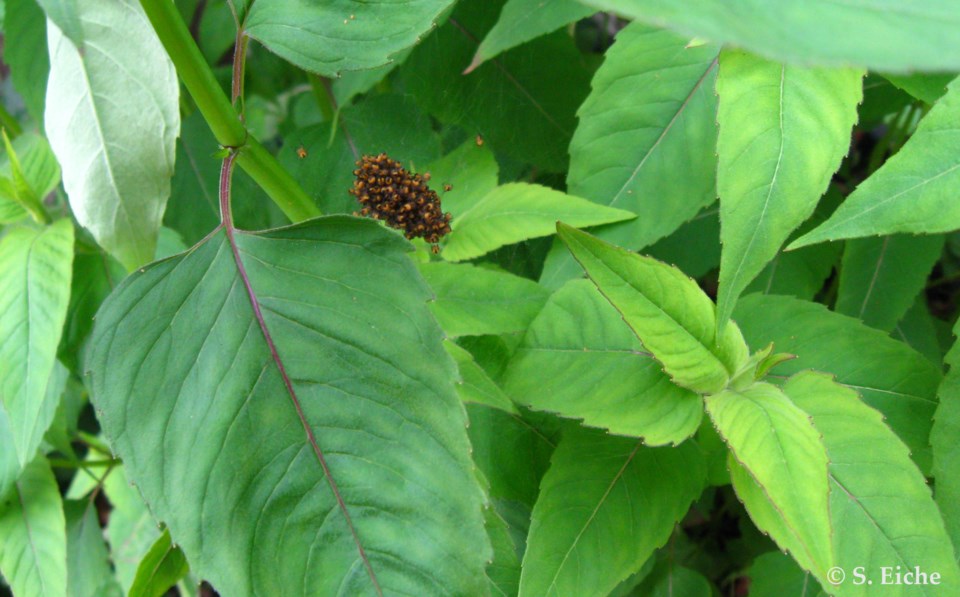You may not be aware of it, but if you get down on your hands and knees when you’re in your garden, you’re close to a world on another scale, a world populated by tiny creatures. They’re oblivious to you unless you interrupt them. Their only concern is to carry on with their life’s work.
Last month, while I was in the garden down on my hands and knees, my eye was caught by something unusual nestling among the bee balm. It was brown and sort of bumpy and had an oblong shape about three-quarters of an inch long. My first thought was that it was a dried flower although I knew this was impossible because the bee balm was just beginning to grow and was many weeks away from flowering. So I touched it. Suddenly the whole brown, bumpy oblong dissolved before my eyes. Total mayhem. It turned out I’d disturbed a spider’s nest and sent the baby spiders scrambling in all directions.
I waited a few hours and then revisited the scene of my ‘crime’. To my relief, the baby spiders had reassembled. When I looked very closely I could make out the most delicate of webs – you could call it gossamer – anchoring the nest to the surrounding leaves. Some of the babies were climbing along the web’s strands.
Another garden bed, another revelation. Cornflowers (Centaurea cyanus) are among my favourite summer flowers, not least of all because they were the first flowers I grew when I was a little girl in Germany. This spring I bought a package of seeds and at the beginning of May scattered them in carefully chosen spots.
Three days later I was sowing sweet peas around an obelisk I’d made out of two tomato cages. The obelisk was at the opposite end of the garden bed from where I’d strewn the cornflowers. Using a small stick, I was making holes in the soil into which I’d drop the sweet peas, careful not to harm the tiny roots already poking out of the seeds.
Even though I was concentrating fully on the task at hand, I noticed something entering my field of vision from the left. It was an ant, and it was carrying one of my cornflower seeds. This wasn’t a case of mistaken identity – cornflower seeds are very distinctive. They look like tiny shaving brushes, and their light colour makes them easy to see against the dark soil. The cornflower seed was larger than the ant and undoubtedly heavier. Yet the ant managed to carry it the length of a long garden bed. Had I been standing up and casting my eye over the garden in a sweeping manner, focusing on the flowers, I never would have seen the ant. I never would have had a glimpse of what was probably one of their routine activities – carrying off seeds – but which for me was a fascinating episode in the story of their secret life.
Not a single one of my cornflower seeds grew where I’d scattered them. However, I have spotted a few of the flowers growing far away from their intended location. The ants must have transported all the seeds, figuring they could put them to good use. The few that ended up taking root and growing may be ones that they dropped in transport. But just seeing that ant hauling one seed in its jaws more than compensates me for my loss. It also taught me a lesson – not to sow seeds directly in the garden but to grow seedlings and plant those.
Visions like these are yours for the taking. All you have to do is get close to the ground, look carefully, and be patient. What you can’t do as easily and readily is listen to the sounds that the tiny garden inhabitants are making. For that, you need special equipment – sensors to stick into the soil and headphones to hear the sounds.
Investigations into who makes what sounds are being conducted by scientists at an agricultural research institution in Hertfordshire, England. They’ve found that the “sound of an earthworm is a distinctive rasping and scrunching. Ants sound like the soothing patter of rain."
Why is it important to investigate these subterranean soundscapes? It’s important because over half of earth’s species live below ground. The figure is estimated to be 59 per cent. Amazingly, only a fraction of them is known to us. Small surprise that scientists believe “noisy soil is generally healthier because it contains a greater range of bugs and worms busying around”.
So if you have a yard or field that’s rich in biodiversity (meaning not just a lawn), rest assured that your soil is booming with subterranean sounds, even if your ear can’t pick them up. What you can do, however, is keep your eyes open. That way, if you can’t hear them, at least you’ll be able to see the dwellers of the soil whenever they chance to wander above ground. That is no small satisfaction.
Sabine Eiche is a local writer and art historian with a PhD from Princeton University. She is passionately involved in preserving the environment and protecting nature. Her columns deal with a broad range of topics and often include the history (etymology) of words in order to shed extra light on the subject.




